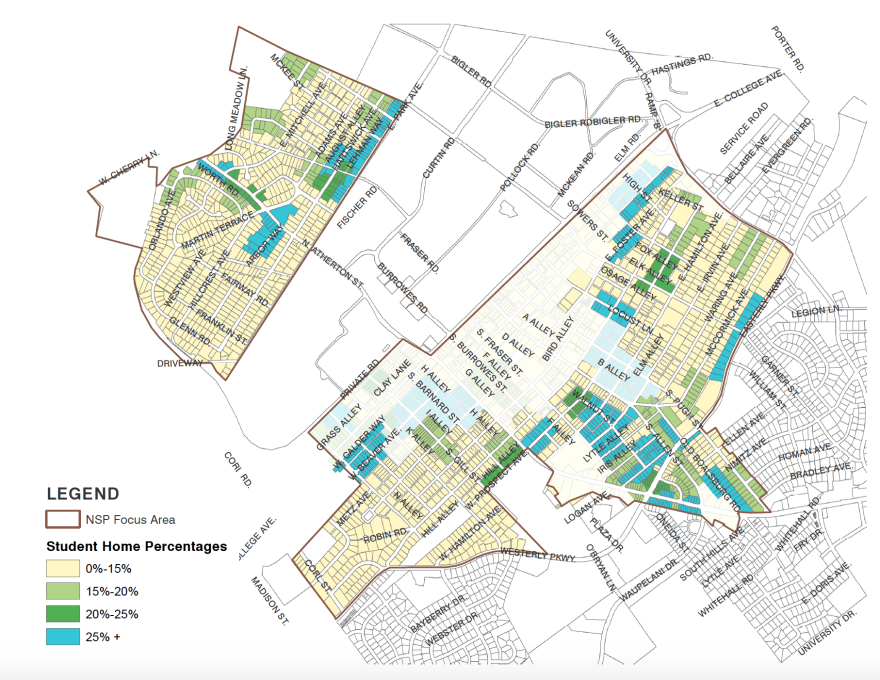It’s just a short walk from the municipal building in downtown State College where Ed LeClear works as borough planning director to a two-story brick house on Foster Avenue with a “For Sale” sign out front. The blocks surrounding it are full of apartment buildings and fraternities, but this block is mostly single-family homes.
The State College Borough’s Redevelopment Authority bought this house, removed the permit that allowed owners to rent it to students and is reselling it as a part of the Neighborhood Sustainability Program.
“It’s a really perfect size for a couple or a young family,” LeClear said.

Competition for houses in the neighborhoods around Penn State University Park drives up prices. And investors renting to students can often afford to pay more for houses than families can. The goal of the Neighborhood Sustainability Program is to maintain diversity in the neighborhoods near downtown, keeping students from taking over.
LeClear says what experts call “studentification” can happen quickly to a block when students move in.
“You really get anywhere from 10 percent to 25 percent of the block being crammed with students, you start to see a shift where then it starts rapidly moving toward 60, 70, 85 percent students,” LeClear said. “So this was really an effort to try to keep a balance recognizing that there comes a tipping point, and it's really relatively early in the percentages where then you start to see long-term residents leave a block.”
The borough is focusing on blocks at that tipping point, not areas that are already overwhelmingly students.
“We don't focus on areas that are, say 75 or even 50 percent greater students,” LeClear said.

He doesn’t know of any other community with a program like this one. It’s an experiment and they’re making changes as they go. The borough took a line of credit of $5 million to run the program for the first three years.
During that initial pilot, the average cost to remove a student rental permit from a house was $61,000. That includes realtor commissions, administrative costs, debt service, carrying costs and a bit of money to fix up the houses. But the majority of the cost comes from a price reduction because of the removal of the valuable student rental permit.
Borough council member David Brown likes the idea of the program, but doesn’t think the impact can justify the cost. Last year, he voted against continuing the program after the pilot.
“What troubles me about it is I guess two things,” Brown said. “I think it’s a very expensive program for one. And I’m concerned that the borough and the authority that administers it can’t really afford it when you look at the actual costs, the operational costs and the other costs involved.”
And secondly, Brown worries there are too many student rentals for this program to make a dent.
“Of the hundreds of student rental houses, student-licensed houses in the borough, I’m not sure at the rate they’re going or with the money we have available we can ever make a significant impact in really reaching the goal of getting enough of them to turn them around,” Brown said.

They’ve bought and resold only about a half dozen houses so far.
After the pilot, the borough made some changes to the program. They now purchase only student rentals that currently have students in them. And LeClear says an important change was to allow property owners rent to non-students. Initially no rental was allowed at all and houses were taking more than a year to sell. LeClear says buyers wanted more flexibility.
“What we found in that was, ‘Yep, I'm a potential buyer. I’m looking at that property. I have no intent to ever rent, but what happens if something happens to me or if I go on sabbatical or I'm deployed or something along those lines?’”
They also made some changes to better compete in the borough’s aggressive real estate market.

A new house in the program is giving LeClear hope that the changes are working. That one sold the same day it was listed and at a higher price than they paid for it.
David Gaines and his family live two doors down from that house. He and his wife bought their house five years ago.
“On the very first night we lived here someone was passed out right where we’re standing at three in the morning or something,” Gaines said. “And I thought she was really far gone and I didn’t know what to do. And I thought ‘Oh, my goodness. What have we got ourselves into?!’”
Gaines said some years the students were great. Other years there were issues. The general disrepair of the house and frequent parties started to affect the surrounding houses.
“What we started to see when this particular house was going downhill was a lot of the neighbors were leaving the neighborhood,” Gaines said. “And the sales prices were impacted. There were two houses that sat on the market for a long time.”
The borough is considering other, potentially cost-effective changes to the program, including buying the student rental permits instead of the homes.
The story is part of a series in partnership with Keystone Crossroads, a collaboration of WPSU and three other public media newsrooms in Pennsylvania.
This story was made possible by funding from the Knight Foundation.






